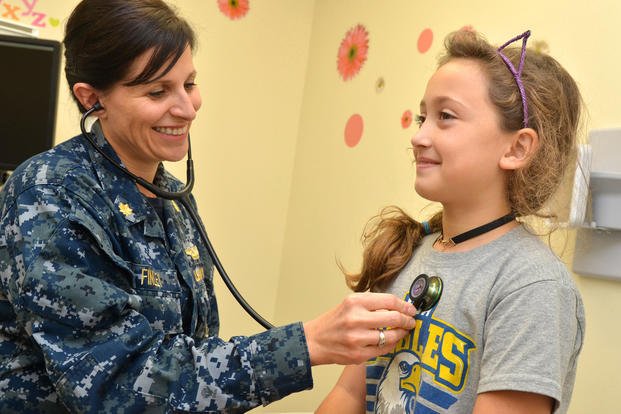The Defense Department has restarted a monumental overhaul of its military health system after a months-long pause during the coronavirus pandemic.
Military health officials said Tuesday that they have resumed the transfer of management of all military medical facilities to the Defense Health Agency, with a goal of completing the transition by Sept. 30, 2021.
The Defense Health Agency also is proceeding with rollout of its MHS Genesis electronic health records system and consolidating health facilities and programs in certain regions into administrative markets. It is also supporting service reviews to determine the necessary mix of medical staff to support troops and beneficiaries, according to Thomas McCaffery, assistant secretary of defense for health affairs.
Read Next: 'Gravely Disappointed;' 14 Fort Hood Leaders Fired, Suspended in Wake of Vanessa Guillen Murder
The pandemic has proven that the military medical system works best when directed by a single entity rather than four separate commands, including the DHA and the medical commands of the Army, Navy and Air Force, McCaffery said Tuesday during the annual meeting of the Association of Military Surgeons of the United States, or AMSUS.
"The pandemic experience has underscored the need for a consolidated enterprise management of our health care system," he said.
The health system overhaul was mandated by Congress in 2017. By law, the DoD is to shift management responsibilities of military hospitals and clinics to the DHA, while the services focus on providing health care to active-duty service members and training medical personnel for combat and deployment care.
As a result, the services are seeking to shed nearly 18,000 frontline health care workers and the DoD has targeted 50 military medical facilities for downsizing or closure.
At the same time, the DoD is introducing a new electronic health record system, MHS Genesis, to select installations.
But these efforts came to a stop March 24 because of the pandemic. McCaffery said Tuesday the initiatives have now resumed.
"We're in the midst of implementing a collection of reforms that, taken together, represented the most dramatic change to the system in over three decades," he said.
McCaffery explained that the DoD has launched its electronic health record system at 21 sites and plans to roll out five additional "waves" in 2021.
The establishment of administrative markets also has resumed, and the DHA is helping the services determine their requirements for military medical personnel, defense officials said.
But one aspect of military health reform -- the restructuring of 50 MTFs, based on community assessments of available medical care through private providers -- will have to be reassessed, Defense Health Agency Director Lt. Gen. Ronald Place said.
The DoD announced in February the list of facilities slated for restructuring based on community assessments of available medical care by private physicians through the Tricare network. Under the plan, 37 outpatient clinics would begin serving only active-duty personnel, and three were slated to close.
But those recommendations will need to be tweaked, since many physician offices and even hospitals cut services or closed permanently during the pandemic, Place said.
"Hundreds, if not thousands, of physician offices have either downsized or closed, and so the assumptions that went into the data ... the data that went into the initial validation of what might be available outside of the gates ... weren't true any more," he said.
The DoD is reassessing the communities and will have new data compiled later this month. Depending on the outcome, the DHA will proceed with realignment and closures in locations where the community can support new patients at private practices, Place said.
"Those areas where it seems as though the capabilities that exist ... [and] really can do that function, we'll set forth a plan for the process of de-scoping capabilities at those installations and the personal handoff of care requirements for individual patients to practitioners outside the gates," he said.
Roughly 200,000 Tricare beneficiaries, including 80,000 active-duty family members, are expected to be affected by the changes.
Critics have called the effort to shift non-uniformed beneficiaries to Tricare simply a form of privatization -- an effort to save taxpayer dollars that undermines the department's obligation to provide care for military personnel and their families.
But McCaffery said the reforms are designed to make sure that the military services have medical personnel trained for warfighting and to improve patient care for all.
"Having both our private-sector care system and our direct care system under one joint entity will allow us to have more standardized health care delivery policies and business practices across the entire military health system. And that will go a long way to reducing undesirable variation for both our providers and our patients," McCaffery said.
In August, the military branches called for a halt to the transfer of medical facilities to the DHA, saying the plan is not viable.
The secretaries of the Army, Navy and Air Force, along with the branch chiefs of the Army, Navy, Air Force, Marine Corps and Space Force, sent a memo to then-Defense Secretary Mark Esper on Aug. 5 calling for the return of all military hospitals and clinics already transferred to the DHA and suspension of any planned moves of personnel or resources.
They said the COVID-19 outbreak has demonstrated that the reform effort introduced "barriers, creates unnecessary complexity and increases inefficiency and cost."
In early March, the Air Force and Army surgeons general told the House Appropriations defense subcommittee that the reorganization is an "extremely difficult [and] complicated merger of four cultures." They suggested that the Defense Health Agency isn't ready for some of the coming changes.
As the pandemic took hold, tensions that had been bubbling since the initial facility transfer erupted. At one facility, commanders and DHA leadership argued over who was responsible for the COVID-19 screening tents in the parking lot.
"There are definitely turf battles going on," said the source, a DoD civilian employee. "[The services] are making it very hard."
If friction continues between the branches and the Defense Health Agency, it was not apparent during a forum at AMSUS that brought together Place and the surgeons general or deputy surgeons general of the military branches.
Navy Surgeon General Rear Adm. Bruce Gillingham said the Navy Bureau of Medicine is committed to training medical professionals to perform in combat and support operational requirements.
Air Force Deputy Surgeon General Maj. Gen. Sean Murphy said the Air Force Medical Service is "really about our operational forces," and Army Surgeon General Lt. Gen. Scott Dingle said his service is honing its forces to ensure that soldiers receive "world-class care."
"We fully understand we must reform. It is the law," Dingle said. "As we go through reorganization, [soldiers] will still get care, the world-class medical response, the world-class engagements they need to ensure that they're ready to go out the door to deploy, fight and win when called upon."
-- Patricia Kime can be reached at Patricia.Kime@Monster.com. Follow her on Twitter @patriciakime.
Related: Many Active-Duty Service Members Are Still Waiting for Flu Shots













